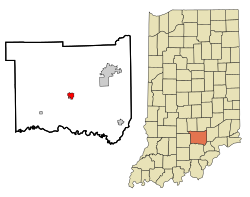Brownstown, Indiana
Town of Brownstown, Indiana | |
|---|---|
 Historic Downtown Main Street | |
 Location in the state of Indiana | |
| Country | United States |
| State | Indiana |
| County | Jackson |
| Township | Brownstown |
| Area | |
| • Total | 1.4 sq mi (3.7 km2) |
| • Land | 1.4 sq mi (3.7 km2) |
| • Water | 0.0 sq mi (0.0 km2) |
| Elevation | 623 ft (190 m) |
| Population (2000) | |
| • Total | 2,978 |
| • Density | 2,083/sq mi (804.1/km2) |
| Time zone | UTC-5 (EST) |
| • Summer (DST) | UTC-5 (EST) |
| ZIP code | 47220 |
| Area code | 812 |
| FIPS code | 18-08470Template:GR |
| GNIS feature ID | 0431647Template:GR |
Brownstown is a town in Brownstown Township, Jackson County, Indiana, United States. The population was 2,978 at the 2000 census. The city is the county seat of Jackson CountyTemplate:GR. It was named for Jacob Brown, a General of the War of 1812.
History
The town of Brownstown was founded 8. April 1816, notably prior to the statehood of Indiana itself. Brownstown became the county seat of Jackson County in November 1816, replacing Fort Vallonia [approximately 3 miles (4.8 km.) SW of Brownstown], which had only been the county seat since June of that year. The land for the Jackson County Court House, which rests in the heart of Brownstown on the square, was donated by Col. John Ketcham (1782–1865) for this specific function.
Geography
Brownstown is located at 38°52′47″N 86°2′46″W / 38.87972°N 86.04611°W (38.879823, -86.046163)Template:GR.
According to the United States Census Bureau, the town has a total area of 1.4 square miles (3.7 km²), all of it land.
Brownstown lies on the East Fork of the White River, bordered by the Jackson-Washington State Forest and very near the Hoosier National Forest.
Demographics
As of the censusTemplate:GR of 2000, there were 2,978 people, 1,168 households, and 805 families residing in the town. The population density was 2,080.6 people per square mile (804.1/km²). There were 1,242 housing units at an average density of 867.7/sq mi (335.3/km²). The racial makeup of the town was 98.76% White, 0.10% African American, 0.24% Native American, 0.24% Asian, 0.10% Pacific Islander, 0.07% from other races, and 0.50% from two or more races. Hispanic or Latino of any race were 0.60% of the population.
There were 1,168 households out of which 34.6% had children under the age of 18 living with them, 49.7% were married couples living together, 16.4% had a female householder with no husband present, and 31.0% were non-families. 28.0% of all households were made up of individuals and 14.0% had someone living alone who was 65 years of age or older. The average household size was 2.43 and the average family size was 2.96.
In the town the population was spread out with 26.8% under the age of 18, 8.8% from 18 to 24, 27.8% from 25 to 44, 19.4% from 45 to 64, and 17.3% who were 65 years of age or older. The median age was 36 years. For every 100 females there were 85.1 males. For every 100 females age 18 and over, there were 76.7 males.
The median income for a household in the town was $35,000, and the median income for a family was $39,044. Males had a median income of $27,984 versus $21,503 for females. The per capita income for the town was $15,525. About 8.9% of families and 11.7% of the population were below the poverty line, including 18.0% of those under age 18 and 6.2% of those age 65 or over.
References

